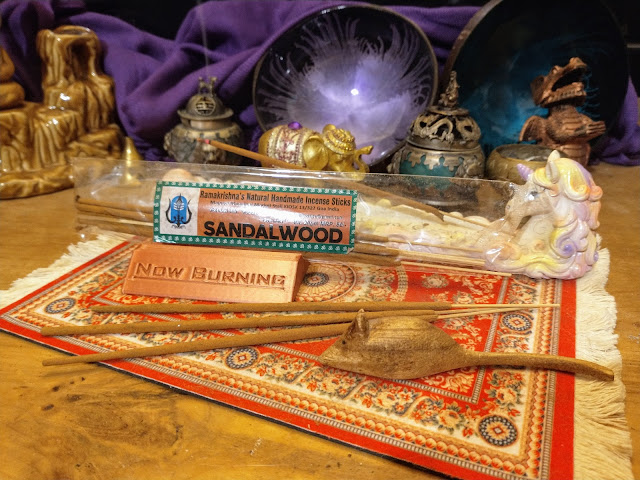Blue Lotus, made by Haridas Madhavdas Sugandhi (HMS) of Pune, and sold by UK importer Gokula as Primo Blue Lotus, and also available as Sacred Elephant Blue Lotus, and Pure Incense Blue Lotus. I am reviewing the Blue Lotus sold as Primo.
I like HMS incense - sometimes I really like it, and some sticks are placed high on my Top of the Dhoops! list. But I don't like that they sell their sticks to so many different resellers at the same time. There was a time in the UK when some brewers were doing that, and there was a kick back by drinkers, who started boycotting brewers who were doing it. I like honesty and transparency. I don't want to buy the same product, two, three, or four times under different names. I like to collect and investigate and experience different incenses - I don't want to be cheated into buying the same incense because somebody simply wanted to make money out of me. I kind of like exploring incenses sold by Pure, Absolute, Happy Hari, ToI, Bhagwan, Blue Pearl, Gokula, etc, because there's often something of a buzz around these companies. And sometimes they are bringing in incense that can't otherwise be bought (you try buying HMS branded incense - it's generally only available in India). And sometimes, as with Eugene of Bhagwan, they discover really exciting unknown incense makers. But, I do wish they would simply sell the incense under the original brand names. I understand the arguments that they want to protect their investment by not revealing their source, but with someone like HMS, most folks who have been buying Indian incense for a few years can identify them from the appearance of the sticks, and the use of vanilla. If you're going to sell HMS incense, sell it in HMS branded boxes so we all know what we're buying BEFORE we buy it! This rebranding means we're buying a cat in a bag instead of the baby pig or rabbit we were expecting.
Rant over....
Right. The masala paste on the stick has the glittery and coloured appearance that much HMS has, and the bamboo splint is also coloured. In this case the paste is coloured mauve while the bamboo splint is coloured red. If you follow the links in the first paragraph you'll see that the Sacred Elephant and Pure Incense Blue Lotus sticks are the same as the Primo sticks. Up to you which you buy, but the incense sold by Gokula generally works out the most economical.
The scent on the stick has the usual HMS vanilla, but also some violets - it's quite warm and seductive, and not quite as sweet as some HMS sticks can be. It burns nice and slowly, introducing the fragrance into the room fairly gently - perhaps too gently. It has the vanilla and violets that were noted on the stick, but there's also some charcoal which kinda intrudes. The lotus scent has not been applied generously enough to really shine. Lotus essential oil is expensive, though essential oils are usually diluted with a carrier, and amplified with agarbatti oil, so the production and retail cost doesn't become prohibitive. Though, synthetic fragrance oils can also be used. And these can be used more generously - sometimes in conjunction with a natural oil, so the maker can honestly say that natural oils were used. I don't know what has been used here, but this is too weak a scent to make a big impression on me. I like it. But without passion.
Date: Feb 2025 Score: 34





















































